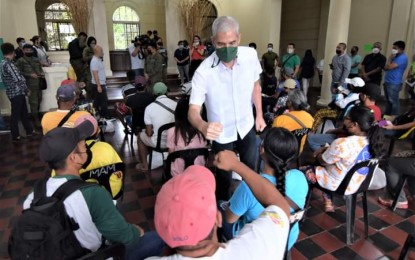Propaganda statement posted to the Communist Party of the Philippines (CPP) Website (Jun 25, 2022): On the 10th ID’s declaration of an almost insurgency-free Southern Mindanao and what it means to peasants in the region
Almost but not quite.
In a press junket on June 21, Major Gen. Nolasco Mempin, commander of the AFP’s 10th Infantry Division, declared in barely-suppressed glee that Davao de Oro, Davao City, Davao del Sur and Davao Occidental were now “insurgency-free.” He also said that it was only one province short, that being Davao Oriental, of declaring the whole of Southern Mindanao to be free of NPA influence. To illustrate his point, he made note of the “cooptation of 1,248 NPAs in the barangays, and more than 6,000 members of the Underground Mass Organizations (UGMOs).”
Let us make the fascist general’s jargon clear: the more than 7,248 individuals he was referring to were all civilian, unarmed peasants, who had suffered relentless red-tagging and harassment and been made to sit through hundreds of hours of either aggressive interrogation or “pulong-pulong” (community meetings) until they had no choice but to acquiesce to “surrendering.”
For peasants and peasant workers across Southern Mindanao, the question of whether insurgency has in fact been stamped out extends far more than the enemy’s statistics achieved mainly through the humongous budget of the NTF-ELCAC and AFP’s state terrorism of relentless militarization, bombings, killings and coercion.
Indeed, how can the flames of peasant unrest be snuffed out when the very reason for its existence is being perennially stoked by widespread landlessness and loss of livelihood? In Southern Mindanao, prime agricultural lands are being gobbled up by banana and other export crop
companies that aggressively expand and encroach even on the Lumad’s ancestral domain, buoyed by the financial and production assistance extended by the reactionary government. Likewise, mining and quarrying in the countryside, which local governments in the region insist posted the fastest economic activity during the pandemic, have displaced peasants in some areas or made farming even more difficult in others.
It boggles our imagination that local governments, dominated by the landlord class, have the nerve to claim that rice sufficiency in Southern Mindanao has risen to 54 percent in 2021 from 47 percent in 2016, when, because of the Duterte regime’s kowtowing to neoliberal policies, prices of farm inputs have consistently skyrocketed while farmgate gate prices of palay either stagnated or dipped, causing loss of income or bankruptcies of rice farmers.
Financing for production in rural villages has also become difficult to come buy, even those that levy usurious interest rates. With prices of pesticides and fertilizers doubling in a span of two years, peasants find themselves opting out of individual farming, and instead desperately looking for seasonal farm work and other odd jobs. In Davao de Oro and Davao del Norte, many so-called CARP beneficiaries were forced to either pawn off their land to settle debts or tie up their land to banana, coffee or cacao farms owned by middle and big landlords. In some areas still, some peasants were forced to sell their lands for various reasons.
Members of Pambansang Katipunan ng mga Magbubukid in Southern Mindanao have reported that in many areas, which used to have rice paddies, corn fields and vegetable farms, food production has dwindled or ceased. “Mingaw na ang uma,” (The farm has gone quiet) is one heartbreaking sentiment shared by a peasant in Davao del Sur.
In the hype and haste of self-congratulatory posturing, the 10th ID and the ultra-sychophantic landlord-bureaucrat capitalists of Southern Mindanao adamantly refuse to behold the biggest twin carabaos in the room, that of feudal and semi-feudal exploitation. These roots of peasant unrest, which bottomlessly fuel the revolutionary armed struggle, are what drives the masses in the countryside to continue to resist in all forms, amid and in spite of the sacrifices and difficulties.
In declaring all but one province in Southern Mindanao as insurgency-free, the 10th ID aims to invalidate the long-standing demand of the peasant class for genuine land reform. After all, despite of the billions it poured into its counterinsurgency campaign and modernization program, the AFP in the region did claim that “about 145 People’s Organizations (POs) with 7,722 members mostly former rebels and mass supporters benefited from various programs and projects from the province which eventually helped them uplift their social and economic status as part of the re-integration program.”
To be sure, these so-called programs and projects such as housing, trainings, and the like are nothing but “compliance activities” meant to bolster the enemy’s counterinsurgency portfolio but are woefully off-mark in addressing the problem of landgrabbing and landlessness. The “POs,” meanwhile, were mere sounding boards of anti-communist propaganda and turned into campaign machineries for Ferdinand Marcos Jr. and Sara Duterte’s stolen victory in the May 9 elections.
On the whole, the tyrannical Duterte regime and the terrorists in the AFP desperately needs to declare Southern Mindanao to be insurgency-free in order to justify their bloody trail of war crimes, obscene military budget-cum-well of corruption, and breathe new life to the NTF-ELCAC and their murderous counterinsurgency campaign. For us peasants, it’s merely hot air coming out of the enemy’s overinflated egos.
In his shameful exit, Duterte leaves behind a blood-stained legacy of a semi-feudal and semi-colonial Philippines, supposedly to be perpetuated by the illegitimate Marcos II regime, where peasants like us are expected to subsist in mumho (food scraps) instead of a decent meal, raise cash crops for export instead of ensuring food security, work as slaves in lands we do not own and act as though all is bright and well. Unfortunately for the enemy, we refuse to.
https://cpp.ph/statements/on-the-10th-ids-declaration-of-an-almost-insurgency-free-southern-mindanao-and-what-it-means-to-peasants-in-the-region/

















